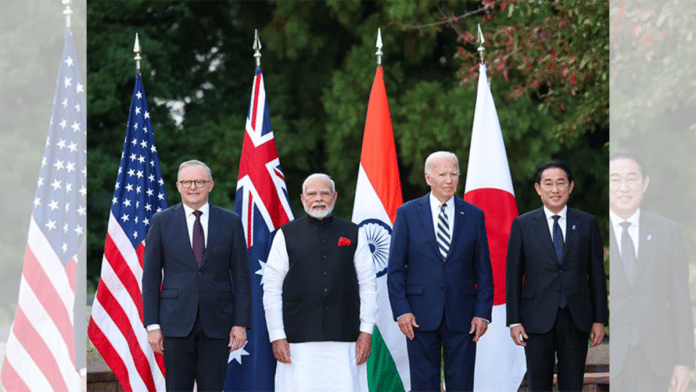The joint statement released at the conclusion of the fourth Quad Leaders’ Summit in Delaware, US, conveyed an overriding message: “The Quad is here to stay.” However, the Quad, comprising India, the US, Japan, and Australia, must do more than just ‘stay’; it needs to thrive for the sake of a stable regional security architecture in the Indo-Pacific. For that to happen, the Quad needs to reassure regional partners that it will put its money where its mouth is.
All Quad members promote the concept and practice of the Association of Southeast Asian Nations’ (ASEAN) centrality in the Indo-Pacific. However, the Quad cannot close its ears to the scepticism nurturing in Southeast Asia that the grouping’s claims of a “real, positive, and enduring impact for the Indo-Pacific” could also mean a comparative erosion of ASEAN centrality, limiting its ability to balance relations between the US and China.
On the other hand, Beijing incessantly labels the Quad as an “Asian NATO” in the making. Therefore, even as the Quad proudly proclaimed that it has built a “vital and enduring regional grouping that will buttress the Indo-Pacific for decades to come,” current geopolitics shows that the grouping has a significant task ahead in reassuring regional allies and partners.
Great power concoction and regional dilemma
Just prior to the Quad Leaders’ meeting in the US, China concluded the 11th Beijing Xiangshan Forum—its answer to the West-led Shangri-La Dialogue on Indo-Pacific defence and security. The Xiangshan forum was reportedly attended by official delegations from over 100 countries and international organisations, along with more than 200 Chinese and foreign experts and scholars. As Beijing flexes its string of commitments to regional and global leadership – the Global Security Initiative (GSI), Global Development Initiative (GDI), and Global Civilization Initiative (GCI) – Southeast Asia finds itself at the centre of a new great power competition.
With perceptions of a relative decline in American influence in the region taking ground, a growing strategic dilemma in Southeast Asia sets in. ASEAN countries, facing China as a proximate power breathing down their necks with its growing military muscle, assertive intent, and tight web of economic ties, must navigate the complexities of US-led and China-led regional initiatives. While they cannot ignore the economic benefits of dealing with China, they also cannot decouple from the security imperative of courting the support of a distant power like the US. Many Southeast Asian countries practice a form of “Bamboo diplomacy”, balancing their relations between China and the US.
However, are ASEAN countries prioritising their national engagements with Beijing while succumbing to the Chinese playbook of driving wedges within the grouping? For instance, as the Philippines enters the most volatile phase in its relationship with China and calls for active US intervention, many countries in the region do not equally prioritise China’s obliterating activities in the South China Sea.
Concurrently, US-China ties are equally complex. Both nations continue to face off in extremely competitive power projection in the Indo-Pacific, particularly over the South China Sea and the Taiwan Strait. Yet, the world’s two largest economies are tightly intertwined through high trade transactions and retaliatory tariff wars. Their power tussle has become a frame of reference for many countries as they reorient their national strategies to promote or, at the least, protect their interests. If Beijing is to be believed, China champions multipolarity and global peace, unlike Washington’s hegemonic tendencies that cause regional instability. Conversely, if Washington is to be believed, China’s predatory economic practices and muscle-flexing are the imminent concerns in the region.
Also read: US-China ties hang between Biden and next president. Recent trips show a lot is on the line
What Quad must do
The Quad’s mandate is huge, and runs like a Christmas wish list of multilateral governance and regional development. Its commitments and initiatives include global health and security, disaster relief assistance, maritime security, climate and clean energy, interoperability cooperation among concerned agencies, quality infrastructure development, cooperation in outer space and emerging technologies, and capacity building. However, an equally important step the Quad must take is to counter disinformation campaigns orchestrated by the Chinese government, which dress up the Quad as a military bloc against China, which would end up destabilising the Indo-Pacific region.
Indo-Pacific partners have put ASEAN centrality as a prime operating principle for multilateral engagements and initiatives. It is a bulwark against China’s territorial transgressions in the South China Sea and its unilateral domination over regional issues. However, loud murmurs among ASEAN members that the Quad could undermine ASEAN centrality cannot be ignored. The Quad needs to be cognisant of differing views among ASEAN countries regarding its role. Being only seven years old, the revived Quad has the task of plugging into a broader network of existing regional mechanisms that China is also courting.
Any rising scepticism and anxiety surrounding the Quad among ASEAN countries should be addressed promptly. In the mid-term, tangible Quad-ASEAN engagements are required through a Quad–plus strategy, while exploring a framework for eventual Quad enlargement needs to be a longer-term goal.
Monish Tourangbam is Director at the Kalinga Institute of Indo-Pacific Studies (KIIPS). Views are personal.
(Edited by Aamaan Alam Khan)






